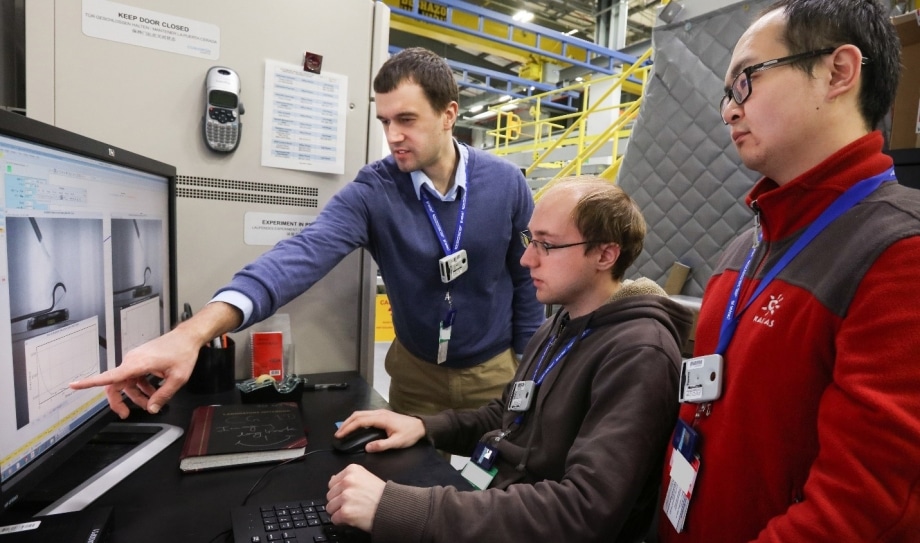Apr 22 2019
By 2023, lithium-ion batteries are projected to have a worldwide market value of $47 billion. They are used in several applications, because they offer comparatively high operating voltage, high energy density (storage capacity), long shelf life and little “memory effect” — a reduction in a rechargeable battery’s maximum capacity because of incomplete discharges in earlier uses. However, factors such as charge-discharge cycling, safety, and operating life expectancy continue to restrict the effectiveness of lithium-ion batteries in heavy-duty applications, such as for powering electric vehicles.
 Associate Professor of Chemical Engineering Gary Koenig (left) and Ph.D. student Ziyang Nie (right) are employing neutron imaging at Oak Ridge National Laboratory to probe lithium-ion battery materials and structures. (Image credit: ORNL/Genevieve Martin)
Associate Professor of Chemical Engineering Gary Koenig (left) and Ph.D. student Ziyang Nie (right) are employing neutron imaging at Oak Ridge National Laboratory to probe lithium-ion battery materials and structures. (Image credit: ORNL/Genevieve Martin)
Chemical engineering scientists from the University of Virginia School of Engineering are using neutron-imaging methods at Oak Ridge National Laboratory to investigate lithium-ion batteries and attain insights into the electrochemical features of the batteries’ structures and materials. Their study, published in the Journal of Power Sources, concentrated on monitoring the lithiation and delithiation — or charge and discharge — processes in lithium-ion battery electrodes using thick and thin sintered samples of two electroactive materials, lithium titanate and lithium cobalt oxide.
Getting an insight into how the lithium moves in battery electrodes is vital in developing batteries that can charge and discharge at faster rates. In certain batteries, this is the slowest process, which means that enhancing the lithium movement via the electrodes could give rise to batteries that can be recharged a lot quicker.
When electrodes are relatively thick, transport of lithium ions through the porous material and separator architecture can limit charge and discharge rates. To develop methods of improving lithium ion transport through an electrode’s porous void regions filled with electrolyte, we need to first be able to track the transport and distribution of the ions within a cell during the charge and discharge processes.
Gary Koenig, Associate Professor of Chemical Engineering, UVA Engineering.
According to Koenig, other methods such as high-resolution X-ray diffraction can offer comprehensive structural data during electrochemical processes, but this technique normally averages comparatively large volumes of the material. Likewise, X-ray phase imaging is capable of visualizing salt concentrations in battery electrolytes, but the method necessitates a special spectrochemical cell and can only gain composition information between the electrode regions.
To gather thorough information across a broader area, the scientists conducted their explorations using neutrons at the cold neutron imaging beamline at Oak Ridge’s High Flux Isotope Reactor.
“Lithium has a large absorption coefficient for neutrons, which means that neutrons passing through a material are highly sensitive to its lithium concentrations,” said Ziyang Nie, lead author and graduate student in Koenig’s group. “We demonstrated we could use neutron radiographs to track in situ lithiation in thin and thick metal oxide cathodes inside battery cells. Because neutrons are highly penetrating, we did not have to build custom cells for the analysis and were able to track the lithium across the entire active region containing both electrodes and electrolyte.”
Comparing the lithiation process in thick and thin electrodes is necessary to help understand the effects of heterogeneity — local differences in mechanical, transport, structural, and kinetic properties — on battery life and performance. Local heterogeneity can also cause non-uniform battery current, state of charge, temperatures, and aging. Usually, as the thickness of an electrode expands, so do the damaging effects of heterogeneity on battery performance. Nevertheless, if thicker cathodes and anodes could be used in batteries without influencing other factors, it would help raise energy storage capacities.
For the preliminary experiments, the thin electrode samples possessed thicknesses of 0.738 mm for lithium titanate and 0.463 mm for lithium cobalt oxide, while the thick lithium titanate and lithium cobalt oxide samples were 0.886 mm and 0.640 mm, respectively.
Our immediate goal is to develop a model to help us understand how modifying the structure of an electrode, such as changing how the material is oriented or distributed, could improve ion transport properties. By imaging through each sample at different points in time, we were able to create 2D maps of lithium distribution. In the future, we plan to rotate our samples within the neutron beam to provide 3D information that will reveal in more detail how heterogeneity impacts ion transport.
Gary Koenig, Associate Professor of Chemical Engineering, UVA Engineering.
The National Science Foundation supported this research.